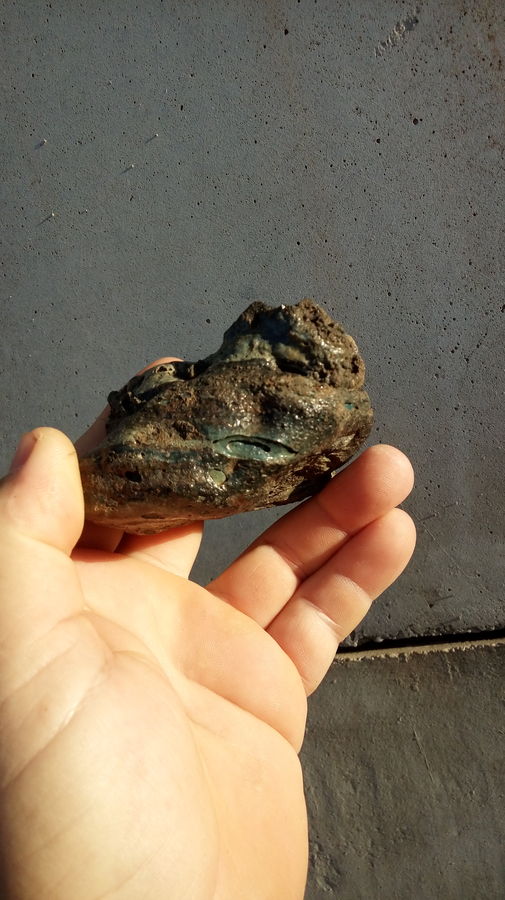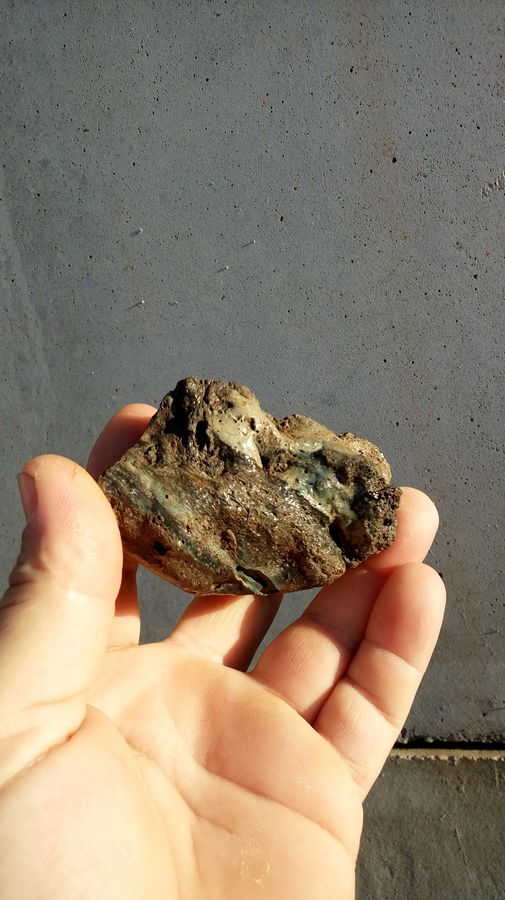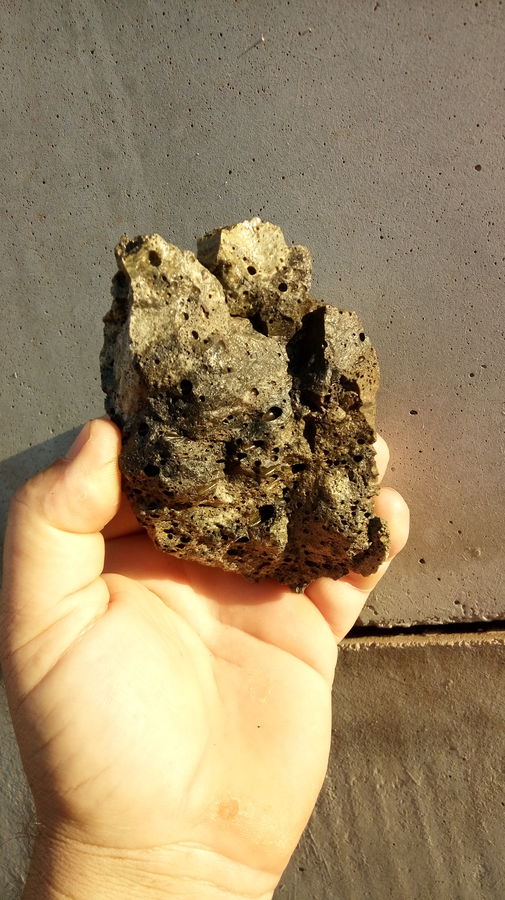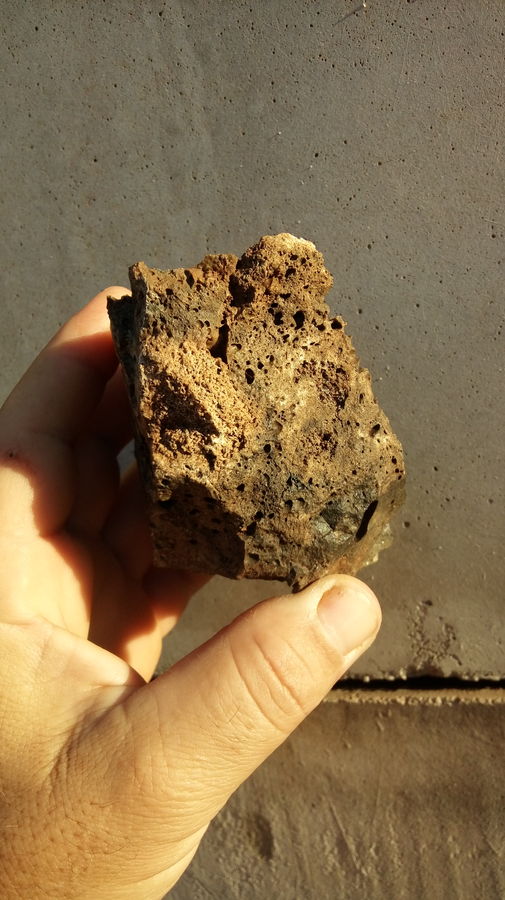| View previous topic :: View next topic |
| Author |
Message |
Robson Vieira
Joined: 05 Jan 2017
Posts: 60
Location: São Paulo


|
 Posted: Jun 21, 2020 16:27 Post subject: I think it is manmade but.... Posted: Jun 21, 2020 16:27 Post subject: I think it is manmade but.... |
|
|
Hi folks. I was walking around in a small park near home and I found two lustrous stuff like a tree root. Obviously, I have investigated the material and I picked it up.
The images below show the material.
They are like a glass material, and one of them has a poor rainbow hue.
Honestly, I think it is a slag, but I would appreciate your most qualified opinion.
The area I found the piece is a basaltic one, where I have found some vesicular basalt as well.
Thanks,
Robson vieira
Colina, SP, Brazil
| Mineral: | Probably a slag |
| Locality: | | São Paulo State, Brazil |  |
|
| Dimensions: | 12 cm x 6 cm |
| Description: |
North São Paulo State
Interesting color and vesicular texture |
|
| Viewed: |
8244 Time(s) |

|
| Mineral: | Probably a slag |
| Locality: | | São Paulo State, Brazil |  |
|
| Dimensions: | 12 cm x 6 cm |
| Description: |
|
| Viewed: |
8249 Time(s) |

|
| Mineral: | Probably a slag |
| Locality: | | São Paulo State, Brazil |  |
|
| Dimensions: | 12 cm x 6 cm |
| Description: |
North São Paulo State
Another one |
|
| Viewed: |
8243 Time(s) |

|
| Mineral: | Probably a slag |
| Locality: | | São Paulo State, Brazil |  |
|
| Dimensions: | 12 cm x 6 cm |
| Description: |
North São Paulo State
Notice the dull colors |
|
| Viewed: |
8233 Time(s) |

|
|
|
| Back to top |
|
 |
Peter Megaw
Site Admin

Joined: 13 Jan 2007
Posts: 975
Location: Tucson, Arizona



|
 Posted: Jun 21, 2020 16:31 Post subject: Re: I think it is manmade but.... Posted: Jun 21, 2020 16:31 Post subject: Re: I think it is manmade but.... |
|
|
Slag...bubble in glass
_________________
Siempre Adelante! |
|
| Back to top |
|
 |
Robson Vieira
Joined: 05 Jan 2017
Posts: 60
Location: São Paulo


|
 Posted: Jun 21, 2020 17:07 Post subject: Re: I think it is manmade but.... Posted: Jun 21, 2020 17:07 Post subject: Re: I think it is manmade but.... |
|
|
| Hi Peter and thank you for your comment. I would like to know how to differentiate slag from natural glass or another natural material. Could you help me? Is there a kind of rule to see?
|
|
| Back to top |
|
 |
Pete Modreski
Site Admin

Joined: 30 Jul 2007
Posts: 710
Location: Denver, Colorado



|
 Posted: Jun 21, 2020 19:21 Post subject: Re: I think it is manmade but.... Posted: Jun 21, 2020 19:21 Post subject: Re: I think it is manmade but.... |
|
|
Hi, Robson,
This is a different Pete answering you, but let me try.
There isn't any one simple answer to what you ask, only some general guidelines. Mostly, it's a matter of experience and familiarity with these kinds of materials.
The only common type of natural glass is obsidian, and it is found only in areas with recent volcanic activity. And because obsidian, compared to many rocks and minerals, is not too hard, and is brittle, and easily worn away by erosion, it is rare to find it as transported pebbles in an stream deposit that is not immediately in a volcanic area. Most obsidian is black and, of course, glassy, but it grades into grayish, cloudy, and "pitchy" looking but not glassy material (perlite). And of course, there are always exceptions--some can be greenish, but that is very rare.
There is also natural glass in the form of tektites, but those are very rare, and only found in certain areas where tektites are common (i.e., Thailand-Vietnam).
There are also "fulgurites", melted soil or rock (usually, sandy soil) from lightning strikes. These are usually grayish in color, very full of bubbles, and quite fragile and easily broken. Fulgurites are also quite rare.
Slag is usually cloudy, not fully transparent glass; often banded to some degree; usually containing a lot of bubbles; and tends to be quite varied/irregular and non-homogenous in its appearance and texture. It can range considerably in color, from greenish to gray to nearly black. Some slag, that is very rich in iron content, can be nearly black, opaque, and will feel unusually heavy. Most slag will have surface features that look obviously like molten liquid has been poured and solidified.
One also finds pieces of solid, clear or partly clear glass, in any color, leftover fragments from a glass-making operation. These usually look distinctly like simply "a broken chunk of colored glass".
I think those are about the best guidelines of advice that I can offer.
Pete Modreski
|
|
| Back to top |
|
 |
Robson Vieira
Joined: 05 Jan 2017
Posts: 60
Location: São Paulo


|
 Posted: Jun 21, 2020 20:42 Post subject: Re: I think it is manmade but.... Posted: Jun 21, 2020 20:42 Post subject: Re: I think it is manmade but.... |
|
|
| Hi Pete. I learned a lot with your explanation. Exactly what I had needed. Thank you.
|
|
| Back to top |
|
 |
Volkmar Stingl
Joined: 23 Sep 2012
Posts: 1013
Location: Innsbruck



|
 Posted: Jun 21, 2020 22:43 Post subject: Re: I think it is manmade but.... Posted: Jun 21, 2020 22:43 Post subject: Re: I think it is manmade but.... |
|
|
| Pete Modreski wrote: | Hi, Robson,
This is a different Pete answering you, but let me try.
There isn't any one simple answer to what you ask, only some general guidelines. Mostly, it is matter of experience and familiarity with these kinds of materials.
The only common type of natural glass is obsidian, and it is found only in areas with recent volcanic activity. And because obsidian, compared to many rocks and minerals, is not too hard, and is brittle, and easily worn away by erosion, it is rare to find it as transported pebbles in an stream deposit that is not immediately in a volcanic area. Most obsidian is black and, of course, glassy, but it grades into grayish, cloudy, and "pitchy" looking but not glassy material (perlite). And of course, there are always exceptions--some can be greenish, but that is very rare.
There is also natural glass in the form of tektites, but those are very rare, and only found in certain areas where tektites are common (i.e., Thailand-Vietnam).
There are also "fulgurites", melted soil or rock (usually, sandy soil) from lightning strikes. These are usually grayish in color, very full of bubbles, and quite fragile and easily broken. Fulgurites are also quite rare.
Slag is usually cloudy, not fully transparent glass; often banded to some degree; usually containing a lot of bubbles; and tends to be quite varied/irregular and inhomogenous in its appearance and texture. It can range considerably in color, from greenish to gray to nearly black. Some slag, that is very rich in iron content, can be nearly black, opaque, and will feel unusually heavy. Most slag will have surface features that look obviously like molten liquid has been poured and solidified.
One also finds pieces of solid, clear or partly clear glass, in any color, leftover fragments from a glass-making operation. These usually look distinctly like simply "a broken chunk of colored glass".
I think those are about the best guidelines of advice that I can offer.
Pete Modreski |
Just for completion, there are two more types of natural glass:
Pseudotachylites are thin, banded glassy masses of molten rock in joints, originating from tectonic movement resp. earth quakes ("tectonic glass").
Frictionites are also mostly thin, banded masses of glass, associated with powdery masses of crushed rock, originating from giant landslides (I only know two cases: Köfels landslide in Tyrol, Austria, and Tsergo Ri landslide in Nepal).
Volkmar Stingl
|
|
| Back to top |
|
 |
alfredo
Site Admin

Joined: 30 Jan 2008
Posts: 1016



|
 Posted: Jun 22, 2020 17:55 Post subject: Re: I think it is manmade but.... Posted: Jun 22, 2020 17:55 Post subject: Re: I think it is manmade but.... |
|
|
| Robson, there are many different types of slag. In several different places in Bolivia I used to find slag that looked like yours - It came from small lime kilns that were widely scattered over the countryside for calcining limestone to get lime. The slag contains melted ash from the wood and brush used as fuel, melted residues from the limestone, and melted clay from the adobe bricks used to build the kiln. Unlike slags from smelting metals, there is usually not much iron in it, so it could be nonmagnetic (unlike slag from smelters, which is commonly magnetic).
|
|
| Back to top |
|
 |
|





